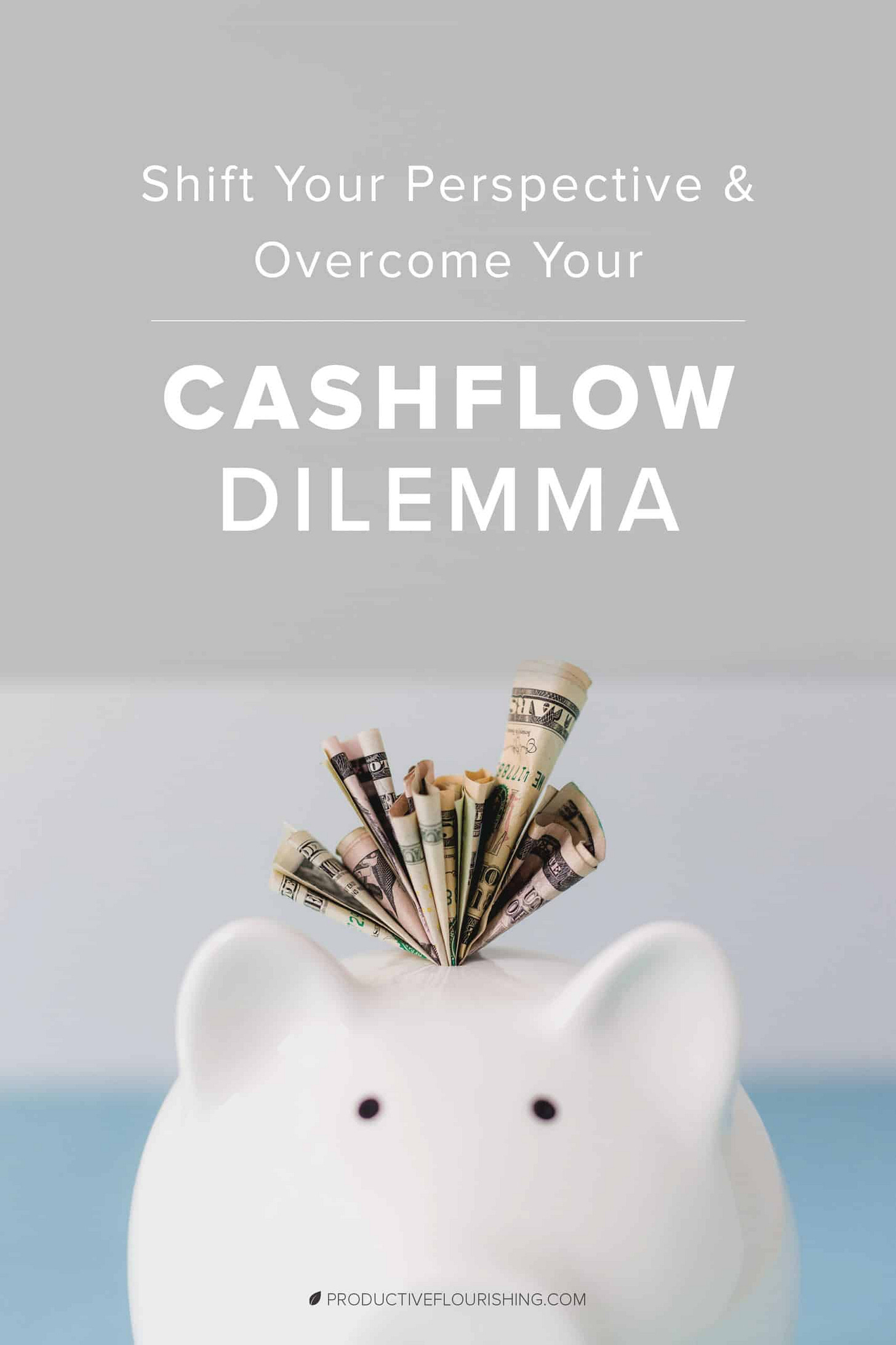When Money Is Tight, Are You Blaming It on Cashflow?

Editor’s note: This is a guest post by Jacquette M. Timmons.
Every business, from the start-up to the “mom-n-pop,” and from the small service and/or product-based business to the multi-national company, eventually encounters a season when money is tight.
Perhaps it looks like sales reaching a plateau, coupled with an anemic pipeline. Maybe it looks like a high burn rate. Perhaps your accounts receivables are outpacing your paid invoices. The details may be different, but the result is the same: More money is flowing out than what’s flowing in.
And that is when money becomes tight and shifts from being a tool that helps you move forward to it being the bottleneck that keeps you stuck and running in place. It is also when you tend to feel stressed and the most vulnerable, financially and emotionally.
When money is the bottleneck in your business due to cashflow, its ramifications can potentially lead to dire outcomes. It could lead to you making decisions and choices you’d never entertain in financially healthier times. Or it could be a “season” that lasts so long that it morphs into a permanent state of being.
But this post isn’t about quitting, nor is it about those instances when the most dire outcome is shutting down or declaring bankruptcy. It is about viewing those seasons when money becomes a bottleneck as good things.
This is crazy hard to do! Mostly because when money is tight, you tend to move into survival mode. But speaking from recent experience, I can proclaim that this season is also an incredible opportunity to evaluate, adapt, and innovate.
Some Background
While this is not my first PF guest post, you may be new to me and my body of work. For background, I work as a financial behaviorist, focusing on the human side of money. I spend my time coaching singles, couples, and entrepreneurs; speaking for AM Law 200 and Fortune 500 companies; hosting live events; and writing. I had a phenomenal year in 2018, so much so that its momentum carried over into the first quarter of 2019.
I bet you can tell where this is going…
I was riding a high and wasn’t paying attention—even though the signs were there. (Aren’t they almost always?!) So when sh*t hit the financial fan in April, I was like a deer in headlights. It had been so long since I went through a season where money was tight that I forgot what it felt like. Thus, April kicked my butt!
The easy, more convenient answer to explain my financial crunch is that a few coaching prospects didn’t materialize. Likewise, some payments for a few of my speaking contracts that “should” have been paid, weren’t. Though both those things are all true, there was a greater, less convenient truth at play: Some part of my business’ foundation had a crack in it.
Signals in the Noise
So, yes, I hit a rough financial patch. Yet I couldn’t shake the words spoken by entrepreneur and early stage investor John Henry, in his business-reality show on VICE: “You’re not lacking resources, you’re lacking resourcefulness.”
For my situation I reframed his quote to, “When you’re short on money, you don’t have a money problem.”
Every day I would ask myself, “Where can I be more resourceful?” Then I added another question to my daily reflection, “If I don’t have a money problem, what is my problem?” By asking the first question, the answer to the second became clear: There was a problem with my foundation. (Tweet this.)
It’s been my experience, whether you work as an entrepreneur or employee, that you rarely see the fault lines in your foundation when things are going well. A weak foundation typically only gets exposed when a storm hits. So I started checking the usual suspects — business model, sales process, pricing strategy, and expenses.
Business model - After spending the last several years tweaking it, I felt this was in good shape.
Pricing strategy - Like my business model, I had been tweaking my pricing strategy and felt like I was in really good shape here, too.
Things got a bit more interesting, though, when I took a look at my sales process and expenses. If you had asked me about their health prior to my cashflow storm, I would have told you it was a work-in-progress, but overall was in good standing. Plus, I finally had a CRM that fit both the way I work and think — and my awesome assistant liked it, too.
Beware Comfort Zones
Unfortunately, no CRM dashboard or report can tell you what I had to come face-to-face with: the fact that I relied too heavily on referrals, and I was overly optimistic about my pipeline.
Yes, having ALL my business come by way of either a referral or because someone heard me speak was and is a tremendous blessing. I am grateful. Heck, those are two of the reasons 2018 was as phenomenal as it was!
However, what I realized is that I let this stunt my proactive selling skills. I wasn’t making the first move. I was so accustomed to using my network to help others that I wasn’t tapping into my network for my own purposes and needs, asking for introductions, or letting as many people as possible know what I was up to.
When it comes to your work and life, do you ever find yourself doing the same?
Thus began my concerted outreach initiative to get out of my comfort zone of letting business come to me. I made it a point to reach out to at least three people daily. I also started creating videos and using them to re-engage with LinkedIn connections I had let go stale. Here’s the ironic result: While April was a tight month in regards to cashflow, the number of office hour calls I had was more than I had had for all of Q1 2019.
But the proactive part of my sales process wasn’t the only area where I needed to make some adjustments. I needed a reality check about my expectations where my pipeline was concerned, too.
Of course I knew not every open deal would close. But I wasn’t behaving that way! When it became clear that some deals wouldn’t close at all, and the timeline for others would take longer than I projected, the pressure was on to back-fill my pipeline. That’s never a good position to be in! The adage, “Plan for the best, prepare for the worst,” was and is one I still need to get better at practicing.
As I worked through my cashflow problem, I realized another irony: I am the queen of saying every expense needs to fight for the right to be on your income statement. Yet I felt self-conscious about calling one vendor to see if I was eligible for a better (read: lower) rate. Why? Because I never thought to question my rate until this financial crunch. Imagine my surprise when I learned that I was overpaying to the tune of $50 per month! Hmm...how many years was I spending $600 that I didn’t have to? Turns out you run the risk of losing a lot more than you bargained for when you’re hesitant to ask, and that thought applies whether you’re asking as part of your sales process or as part of your expense management duties.
Self-Examination
So...whether you work as an entrepreneur or employee, what does my story make you consider about you and your foundation, financial or otherwise? Would you describe it as strong or weak? If it is strong, what are you going to do to be (even) better prepared for the next financial storm? If it is weak, what are you going to do to get out of your comfort zone so that you can make your foundation stronger?
Money, or more precisely the lack thereof, is what got me to pay attention. Turns out, though, it wasn’t the true bottleneck in my business’ growth. It wasn’t why my foundation wasn’t as strong as it could be. I was the culprit.
We often hear the phrase, “Business is personal.” When used, it often refers to how you relate to those you serve, clients, vendors, teammates, business partners, etc. Yet, it is also personal because of how your business spotlights what you need to work on from a personal development perspective.
In sharing my story, it’s my hope that the next time you encounter a season where money is tighter than you’d prefer that you’ll first see it as an invitation to reevaluate the strength of your foundation. And second, I hope that you will then make the (perhaps uncomfortable) decisions and choices to strengthen it because, when you find yourself short on money, you likely don’t have just a money problem. Identify and tackle the non-money factor. In my experience, this is what will get you on the other side of the bottleneck and propel you forward!









